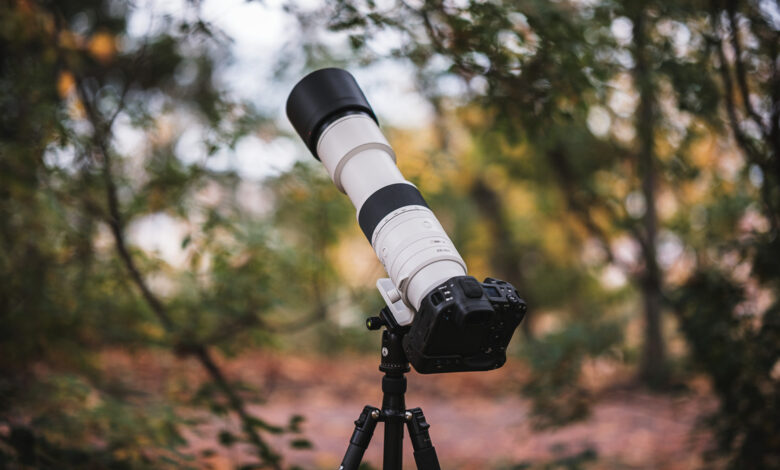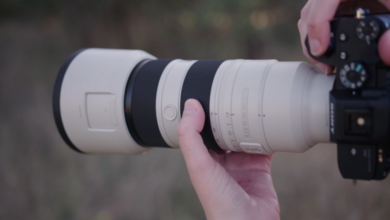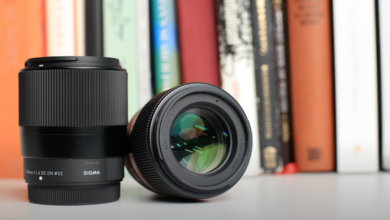The Ultimate Aerial and Wildlife Lens? We Review the New Canon RF 200-800mm f/6.3-9 IS USM

Canon has just announced their longest zoom lens for the RF mount, the RF 200-800mm f/6.3-9 IS USM ,and we’ve tried it in the real world. How was it? Pretty damn enjoyable! Is it worth considering? We certainly believe so! But there is a downside to it. Let’s have a proper look at the new telephoto.
It’s Not a Small Lens, Naturally
With an imposing range of 200-800mm, the lens simply cannot be small. But that is expected. What is surprising, however, is the lens’ weight. Yes, 2.05 kilograms is not light, but considering the siz,e it is pleasantly lightweight in hand, and once you mount a camera on the back of it, it is perfectly balanced regardless of your chosen focal length. It neatly stands on its tripod collar, which doubles as a smooth, rounded handle but unfortunately lacks built-in Arca-Swiss compatibility. Of course, the collar rotates to allow for vertical shooting. It does, however, lack clear stops at 0 and 90 degrees, so you do have to rely on the camera’s internal spirit level or align the engraved notches on both the body of the lens and the collar. The option to attach a strap directly to the lens is welcome. I did not feel any discomfort carrying the lens mounted on a Canon EOS R3 all day this way. It was kept neatly tucked away on my back when not in use and easily accessible when needed.
The body of the lens is white as we’re used to with the majority of Canon’s telephoto offerings. But it does not carry the famous red ring. Yes, indeed, the RF 200-800mm f/6.3-9 IS USM is not of the “L” family. This should please many who were worried about the cost of the lens. The red ring is generally considered for the luxury and more costly lenses of Canon’s multiple lineups. I was told the main reason for the lens not being decorated by the red ring is the aperture but more on the actual diaphragm later.
The design is simple, effective, and somewhat beautiful. The majority of the barrel is streamlined with next to no unnecessary protrusions or quirks. Just a sleek shape with a few basic controls, and that’s it. Those are the three rings, two FN buttons, and two switches. The first and largest ring is most obviously in charge of your focal length. It is black and rubberized for a solid grip. The travel is not too long nor too short. It feels just right. The aforementioned tripod collar can get in the way when you’re shooting handheld, though, so for those occasions, it is much more comfortable to either rotate it upwards to use as a handle or remove it completely.
The tightness of the zoom is adjustable using the second smaller white ring right behind the zoom ring. It has “smooth” and “tight” settings, and the direction of the travel fits nicely with the direction of the zoom ring. I’d usually collapse the lens back to 200 millimeters and then just grab the tightness ring and keep going in the same direction, locking the zoom ring. This stops the front element from creeping downward when not in use.
The last ring serves two purposes, as we’ve already seen with other RF mount lenses like the RF 50mm f/1.8 STM. You can either use the ring for manual focus or you can flip a switch on the body of the lens and use the ring to control one of your pre-set values like aperture, ISO, shutter speed, or exposure compensation. The second switch on the lens toggles your image stabilization. There are no multiple IS modes like we are used to with telephoto lenses on the switch itself.
Even though the front element comes out as you zoom, the lens is still weather-sealed against the elements. However, Canon says it is not at the same level as their “L” series lenses. So, a light rain should be okay, but I’d be careful taking it to a rainforest when you’re expecting to go all Forrest Gump with “Rain that flew in sideways.”
It Is Not the Brightest
Speaking of rainforests, there might be another reason to not want to use this lens in such an environment. The brightest the RF 200-800mm can go is f/6.3 on the short end of 200 millimeters. Once you zoom out to 800 millimeters, your aperture drops down to f/9. The entire time I shot with it, my ISO has rarely dropped down to triple digits. More often than not, I had to use ISO values ranging from 1000 to 6400 just to keep my shutter speed fast enough. And that was in the middle of the day with a slight overcast. Thankfully though, cameras like the R6 Mark II or the R3 I used are brilliant at higher ISO numbers, and their noise levels are very much manageable. Looking at the final images, I am very pleased with the results even at high ISO numbers. The smaller aperture might be the price for a lighter and more affordable extreme telephoto, but seeing what is Canon capable of with their new sensors, it is a price worth paying.
Fast AF
The aperture poses no issue for the AF system. Canon’s Dual-Pixel AF does not worry about how dark the image is up to -7.5EV when you’re shooting with the R3, so a darker aperture should be perfectly fine. This is especially true thanks to the compatibility with the RF teleconverters. The 2x one allows you to go up to 1,600 millimeters with the brightest aperture of f/18. Perfect for aerial photography, birds in flight, or with good enough equipment, I’d even imagine this lens being pretty interesting to photograph the Sun or the Moon. With a good astrotracker, you could even try capturing parts of the universe at night.
The motor keeping your focusing group in motion is Canon’s Nano USM promising fast subject acquisition and easy tracking while staying fairly quiet and perfectly accurate. I honestly can not name a single occasion where the lens would fail me in terms of speed or accuracy. My keeper rate was near 100% unless I was shooting through dense foliage and the camera had a hard time acquiring the subject. The only downside I’d point out would be the lack of a focus limiter switch. The ability to physically set a limit from, let’s say 10 meters to infinity would be nice.
Plenty of Detail
I understand using the lens on the R3 might not show its capabilities fully in terms of sharpness and detail compared to the high-resolution R5, but I went for speed and accuracy instead. 24 megapixels is plenty since I did not need any cropping thanks to the focal length of the lens. I did, as mentioned above, have to shoot at fairly high ISO values, so the images rendered might not be at the lens’s best possible resolving power. Nonetheless, the images came out crispy, with plenty of detail and with next to no color aberrations if you disregard color noise of the sensor.
Of course, it is not on the same level as the brilliant RF 100-500mm f/4,5-7,1 L IS USM or any of the telephoto primes like the RF 400mm f/2,8 L IS USM, but we’re talking about a wholly different ballpark of price and build. “L” series lenses carry their red band for a reason. But that does not mean the RF 200-800mm f/6.3-9 IS USM is in any way, shape, or form a lens to disregard. On the contrary. It is a mighty fine collection of glass and technology capable of satisfying many sports and wildlife shooters out there. I wouldn’t even consider myself being a wildlife photographer, but I have to say, I thoroughly enjoyed my time with this lens mounted on the R3. I’d even be more than happy with an R6 Mark II. There is something soothing about capturing animals, and the 200-800mm makes it a blast.
What I Liked
- Low weight considering the focal range and size
- The long and comfortable handle on the tripod collar
- Adjustable zoom ring
- Good balance when mounted on a tripod
- Sleek design
- Fast AF
- Silent operation
- 5.5 stop IS
- Weather-sealing
What I Disliked
- Lack of collar stops at 0 and 90 degrees
- Collar in the way of zooming when facing down
- Smaller aperture meant higher ISO
- Lack of focus limiter switch
Samples




